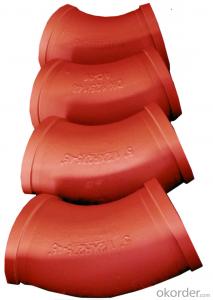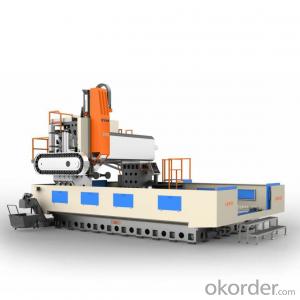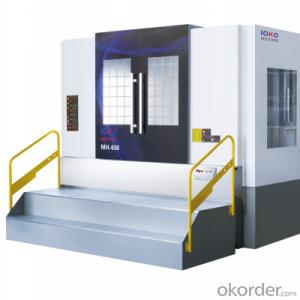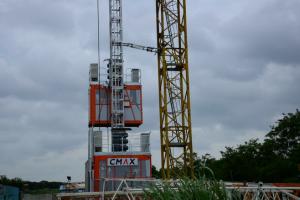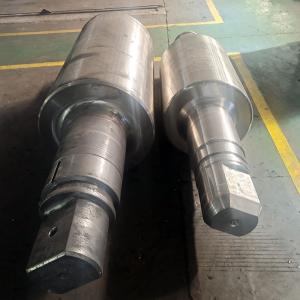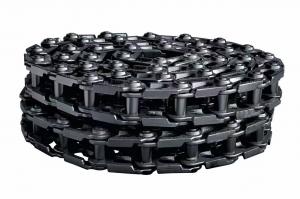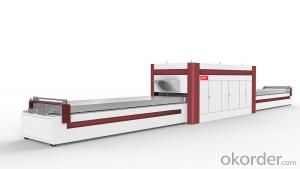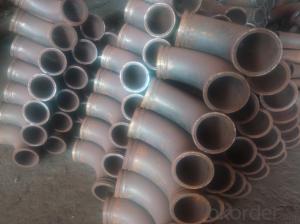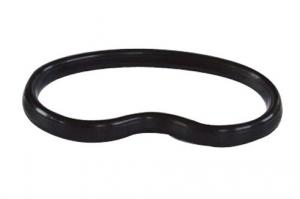CONCRETE DELIVERY ELBOW PM TYPE 30DEG R275 DN125
- Loading Port:
- Tianjin
- Payment Terms:
- TT OR LC
- Min Order Qty:
- 100 pc
- Supply Capability:
- 10000 pc/month
OKorder Service Pledge
OKorder Financial Service
You Might Also Like
concrete pump elbow table
Wear-resistant Single or Double Concrete Pump Elbow | |||||||
Type | Singe Elbow | Double Elbow | |||||
Model | DN125 | DN150 | DN175 | DN125 | |||
Material | Casting Steel ,ST52 | Inside | 40Cr | Outside | |||
Size | R275*90° | R275*90°+110 | 36° | F2000 | R275*90° | R275*90°+110 | |
R275*45° | R275*90°+211 | R400*30° | A3000 | R275*45° | R275*90°+211 | ||
R275*25° | R275*90°+411 | R400*45° | 471B | R275*25° | R275*90°+411 | ||
R275*20° | R275*90°+424 | R400*30° | 571B | R275*20° | R275*90°+424 | ||
R275*15° | R275*45°+170 | R488*90° | A1000 | R275*15° | R275*45°+170 | ||
R180*90° | R275*45°+310 | R500*90 | C1000 | R180*90° | R275*45°+310 | ||
R232*60° | R275*45°+310 | R280*90° | B2000 | R232*60° | R275*45°+310 | ||
R240*36° | 20°Lengthen | R240*36° | 20°Lengthen | ||||
R240*30° | 25°+740 | R240*30° | 25°+740 | ||||
R240*15° | 40°Zoomlion | R240*15° | 40°Zoomlion | ||||
R385*29° | R385*29° | ||||||
R315*33° | R315*33° | ||||||
Technic | Forged | ||||||
Average life | 25,000cubic | 50,000cubic | |||||
Appliciation | Used in concrete transport in construction work | ||||||
1.product profile:The double layer concrete pump elbow is developed by ourselves through new
technology and process.
2.characteristic:the inner layer of this concrete pump elbow undergoes heat treatment,and then the rigitiry can reach 62-65HRC.
3.characteristic:the outer layer of the concrete pump elbow possess good toughness properties
to protect the inner layer,so the security of the elbow is improved.
4.life:the experiment done abroad shows that the life of our concrete pump elbow can reach 35000-50000cbm,got the customers' praise
5.Beside the double layer concrete pump elbow,we produce all kinds of concrete pump parts,
straight pipe hose flange coupling and so on.
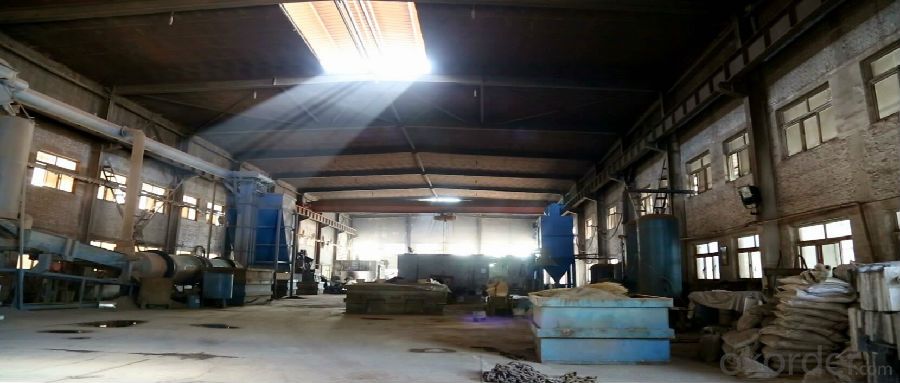
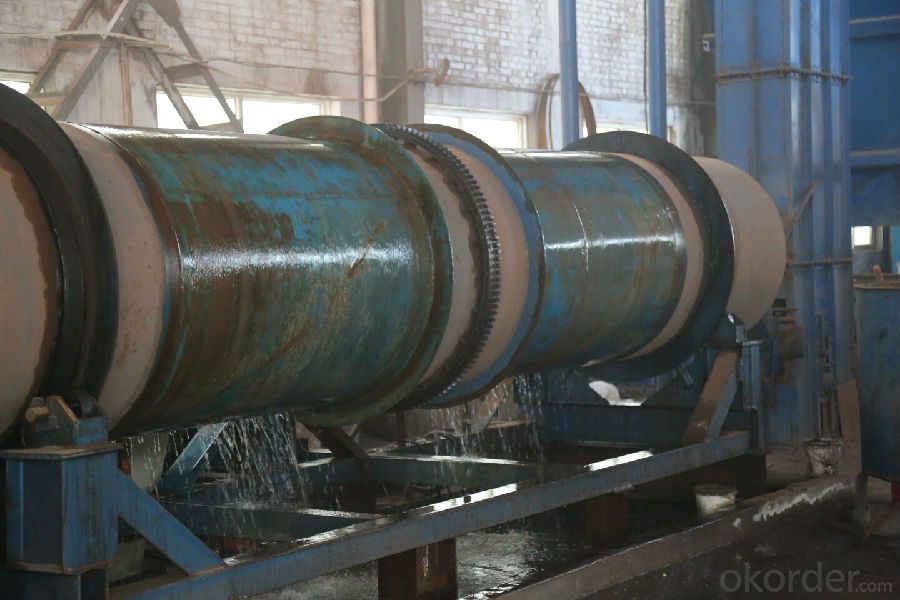

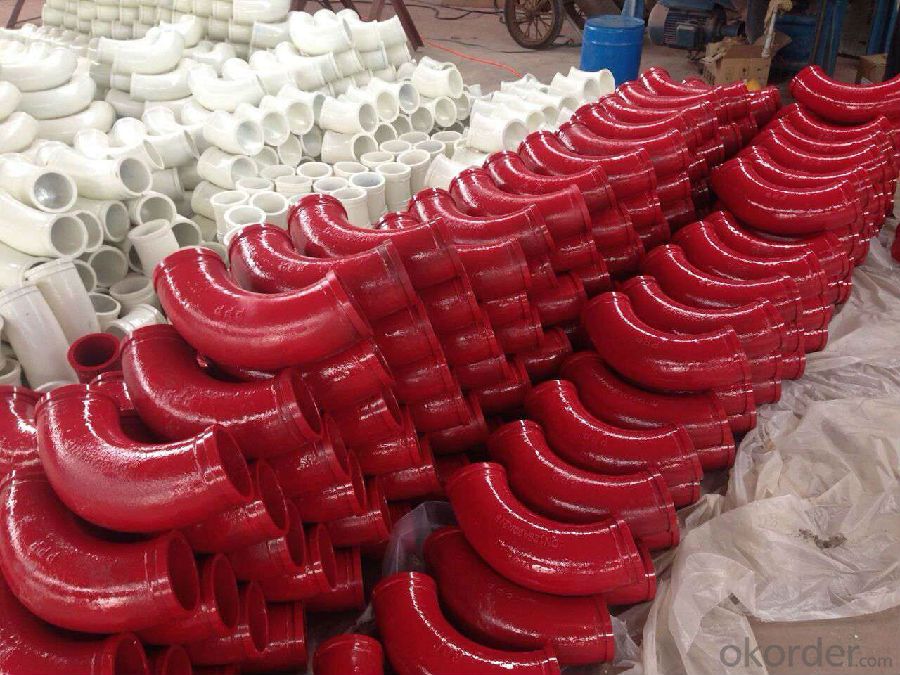
- Q:How can one determine the correct viscosity and temperature range for lubricants used in concrete pump spare parts?
- Determining the correct viscosity and temperature range for lubricants used in concrete pump spare parts involves considering several factors. Here are some steps to help you determine the appropriate viscosity and temperature range: 1. Consult the manufacturer's guidelines: The first step is to refer to the manufacturer's recommendations or guidelines for the specific concrete pump spare parts. The manufacturer may provide specific viscosity and temperature range requirements for the lubricants used in their equipment. 2. Understand the operating conditions: It is crucial to have a clear understanding of the operating conditions in which the concrete pump spare parts will be used. Factors such as ambient temperature, pump speed, load, and pressure should be considered. These factors can significantly impact the lubricant's viscosity requirements and temperature range. 3. Consider the lubricant's performance characteristics: Different lubricants have varying performance characteristics that make them suitable for specific applications. Look for lubricants that are specifically formulated for heavy-duty applications, provide excellent wear protection, and have good thermal stability. These performance characteristics will ensure that the lubricant can withstand the demanding conditions of a concrete pump. 4. Viscosity requirements: The viscosity of a lubricant is a critical factor in ensuring proper lubrication and protection of the concrete pump spare parts. Higher viscosity lubricants are generally recommended for heavy-duty applications, whereas lower viscosity lubricants are suitable for lighter loads. The viscosity requirements may also vary based on the specific pump parts, such as bearings, gears, or seals. Referring to the manufacturer's guidelines and consulting with lubricant suppliers can help determine the ideal viscosity range for the concrete pump spare parts. 5. Temperature range: The temperature range in which the concrete pump operates is another crucial aspect to consider. Lubricants should be able to maintain their viscosity and performance across the expected temperature range. Extreme temperatures can cause lubricants to lose their effectiveness, leading to equipment damage or failure. Therefore, it is important to select lubricants that have a temperature range suitable for the operating conditions of the concrete pump. 6. Seek expert advice: If you are unsure about the correct viscosity and temperature range, it is always advisable to consult with lubricant manufacturers, suppliers, or industry experts. They can provide valuable insights and recommendations based on their expertise and experience with concrete pump spare parts. By considering the manufacturer's guidelines, understanding the operating conditions, evaluating the lubricant's performance characteristics, and seeking expert advice, you can determine the correct viscosity and temperature range for lubricants used in concrete pump spare parts. This will help ensure optimal lubrication and prolong the lifespan of the equipment.
- Q:What is the concrete delivery pump?
- Concrete pump, also called concrete pump, consists of pump body and pipe
- Q:How often should hydraulic oil filters be replaced in a concrete pump?
- The frequency of replacing hydraulic oil filters in a concrete pump depends on various factors including the operating conditions, the type of oil used, and the manufacturer's recommendations. Generally, it is recommended to replace hydraulic oil filters in a concrete pump every 500 to 1000 operating hours or every 6 to 12 months, whichever comes first. However, it is essential to consult the concrete pump's operation manual or the manufacturer's guidelines to determine the specific replacement interval for the hydraulic oil filters. Regularly monitoring the filter's condition and conducting routine maintenance checks can also help in determining if a filter replacement is needed sooner than the recommended interval.
- Q:What are the signs of wear and tear in concrete pump spare parts?
- Concrete pump spare parts may exhibit signs of wear and tear, which should not be overlooked. Some indicators include: 1. Surface damage: Cracks, dents, or scratches on pipes and hoses can signify wear and tear, particularly if they are extensive or deep. 2. Corrosion: Metal components like couplings or clamps may display signs of corrosion such as rusting or pitting, which can weaken the part and affect its functionality. 3. Leaks: Notable leaks in seals or gaskets can suggest wear and tear. Material degradation or improper installation can cause leaks, impacting the pump's efficiency and performance. 4. Decreased performance: Wear and tear in concrete pump spare parts can result in reduced overall performance. For instance, worn-out wear plates can diminish pumping capacity or increase energy consumption. 5. Heightened noise or vibrations: If noise levels or vibrations intensify while operating the concrete pump, it may indicate wear and tear in the spare parts. Imbalances, misalignments, or loose components can negatively affect the pump's performance and lifespan. 6. Excessive wear on moving parts: Moving parts like pistons or cylinders may exhibit excessive wear and tear, such as scoring or grooving on the surface. This can impede the smooth operation of the pump and potentially cause further damage if left unaddressed. Regular inspection and maintenance of concrete pump spare parts are vital to promptly identify and address any signs of wear and tear. Timely replacement or repair of worn-out components can prevent further damage, ensuring the concrete pump operates efficiently and safely.
- Q:Are there any specific safety precautions while replacing concrete pump spare parts?
- There exists a variety of safety precautions that must be followed when replacing concrete pump spare parts. 1. Personal Protective Equipment (PPE) is of utmost importance and should be worn to safeguard against potential hazards. This includes safety goggles, gloves, a helmet, and steel-toed boots. 2. It is essential to adhere to proper lockout/tagout procedures prior to replacing any spare parts. This entails disconnecting and securing the power source to prevent accidental startup of the pump. 3. Before commencing the replacement process, inspect all tools and equipment for any indications of damage or defects. It is crucial to refrain from using faulty equipment, as it can pose significant safety risks. 4. When handling heavy spare parts, it is imperative to employ appropriate lifting techniques to prevent strain or injury. Ensure that proper assistance and equipment, such as cranes or forklifts, are available if necessary. 5. Maintain a clean and well-organized work area to prevent trips, slips, and falls. Remove any obstacles or debris that may jeopardize safety during the replacement process. 6. Only trained and authorized personnel should be involved in the replacement of concrete pump spare parts. They must possess a thorough understanding of the equipment and procedures to minimize the likelihood of accidents. 7. Always consult the manufacturer's guidelines and instructions when replacing spare parts. This will ensure that the process is executed safely and accurately. 8. It is vital to have a plan in place for potential emergencies, including fires or injuries. Make certain that fire extinguishers and first aid kits are easily accessible, and that all workers are familiar with their locations and usage. By adhering to these safety precautions, the risk of accidents, injuries, and damage can be significantly reduced when replacing concrete pump spare parts.
- Q:What are the potential risks associated with the installation and replacement of concrete pump spare parts?
- The potential risks associated with the installation and replacement of concrete pump spare parts include: 1. Safety hazards: Improper installation or replacement of spare parts can lead to accidents and injuries, as concrete pumps involve heavy machinery and high-pressure systems. Inadequate training or lack of knowledge can result in mishandling of equipment, leading to accidents for both the operators and nearby personnel. 2. Equipment damage: If the spare parts are not installed correctly, it can cause damage to the concrete pump or other components. This may result in costly repairs and downtime for the equipment, impacting productivity and project timelines. 3. Performance issues: Using incorrect or low-quality spare parts can affect the overall performance and efficiency of the concrete pump. It may result in reduced pumping capacity, increased wear and tear, and decreased reliability, compromising the quality of the concrete being pumped. 4. Warranty and liability concerns: Installing unauthorized or incompatible spare parts can void the manufacturer's warranty, leaving the responsibility for repairs and maintenance solely on the user. In case of any accidents or damages caused by faulty installation, the liability may fall on the individuals or companies responsible for the installation or replacement. To mitigate these risks, it is crucial to ensure proper training and certification for the personnel involved in the installation and replacement of concrete pump spare parts. Adhering to manufacturer guidelines, using genuine spare parts, and regularly inspecting and maintaining the equipment can also minimize potential risks and ensure safe and efficient operations.
- Q:How often should hopper grate handles be inspected or replaced in a concrete pump?
- Hopper grate handles in a concrete pump should be inspected regularly for any signs of wear and tear or damage. The frequency of inspection and replacement may vary depending on the usage and condition of the equipment. It is recommended to inspect the hopper grate handles at least once a month or after every 500 hours of operation, whichever comes first. During the inspection, ensure that the handles are securely attached to the hopper grate and check for any cracks, bends, or other structural issues. If any damage is detected, it is advisable to replace the handles immediately to prevent any accidents or further damage to the equipment. It is also important to follow the manufacturer's guidelines and recommendations for maintenance and replacement of hopper grate handles. By regularly inspecting and replacing the handles as needed, you can ensure the safe and efficient operation of the concrete pump.
- Q:Are there any specific guidelines for the disposal of old or damaged concrete pump spare parts?
- Old or damaged concrete pump spare parts must be disposed of according to specific guidelines. To ensure environmental sustainability and comply with local regulations, it is important to dispose of these parts properly. Here are some steps to follow: 1. Hazardous material identification: Prior to disposal, it is crucial to determine if the spare parts contain any hazardous materials such as oils, lubricants, or chemicals. These substances require special handling and cannot be disposed of in regular waste streams. 2. Separation of recyclable materials: If the spare parts are made of recyclable materials like metal or plastic, it is advisable to separate them from other waste. Recycling these materials helps conserve resources and reduces the strain on landfill sites. 3. Contact waste management authorities: Each region has its own guidelines and regulations for disposing of specific materials. It is recommended to reach out to local waste management authorities to understand the proper procedures for disposing of concrete pump spare parts in your area. 4. Arrange for proper disposal: Once hazardous materials have been identified and recyclable parts have been separated, make arrangements for their proper disposal. This may involve contacting specialized waste management companies that handle hazardous materials or taking them to designated recycling centers. 5. Avoid illegal dumping: It is essential to refrain from illegally dumping old or damaged concrete pump spare parts. This can harm the environment and may result in fines or penalties. Always dispose of these parts through legal and responsible channels. By adhering to these guidelines, you can ensure the appropriate disposal of old or damaged concrete pump spare parts, minimize environmental impact, and comply with local regulations.
- Q:Can concrete pump spare parts be pre-assembled or pre-tested before installation?
- Yes, concrete pump spare parts can be pre-assembled and pre-tested before installation. This practice ensures that the spare parts are functioning properly and ready for immediate use, saving time and effort during the installation process. Pre-assembly and pre-testing also help identify any potential issues or defects, allowing for necessary adjustments or replacements before installation, ensuring the smooth operation of the concrete pump.
- Q:What are the signs of a malfunctioning concrete pump outrigger?
- There are several signs that indicate a malfunctioning concrete pump outrigger. 1. Uneven or unstable platform: If the outrigger is not functioning properly, you may notice that the platform is uneven or unstable. This can be observed when the pump is not level or when there is excessive movement or shaking of the platform. 2. Leakage of hydraulic fluid: A malfunctioning outrigger may have leaks in the hydraulic system. If you notice any signs of hydraulic fluid leaking from the outrigger, such as puddles or stains on the ground, it is an indication that there is a problem. 3. Slow or unresponsive movement: When operating the outrigger, if you notice that it is slow to extend or retract, or if it does not respond to the controls, it may be a sign of a malfunction. This can be dangerous as it can affect the stability of the pump. 4. Unusual noises: Unusual noises, such as grinding, whining, or knocking sounds coming from the outrigger, can indicate mechanical issues or loose components. These noises should not be ignored as they may signify underlying problems that need to be addressed. 5. Visual damage: Inspect the outrigger for any visible damage, such as bent or cracked components, loose bolts, or missing parts. These physical signs of damage can affect the functionality and stability of the outrigger. It is important to regularly inspect and maintain the concrete pump outrigger to ensure safe and efficient operation. If any of these signs are present, it is recommended to stop using the pump and have it inspected and repaired by a qualified professional to prevent further damage or accidents.
1. Manufacturer Overview |
|
|---|---|
| Location | |
| Year Established | |
| Annual Output Value | |
| Main Markets | |
| Company Certifications | |
2. Manufacturer Certificates |
|
|---|---|
| a) Certification Name | |
| Range | |
| Reference | |
| Validity Period | |
3. Manufacturer Capability |
|
|---|---|
| a)Trade Capacity | |
| Nearest Port | |
| Export Percentage | |
| No.of Employees in Trade Department | |
| Language Spoken: | |
| b)Factory Information | |
| Factory Size: | |
| No. of Production Lines | |
| Contract Manufacturing | |
| Product Price Range | |
Send your message to us
CONCRETE DELIVERY ELBOW PM TYPE 30DEG R275 DN125
- Loading Port:
- Tianjin
- Payment Terms:
- TT OR LC
- Min Order Qty:
- 100 pc
- Supply Capability:
- 10000 pc/month
OKorder Service Pledge
OKorder Financial Service
Similar products
New products
Hot products
Related keywords



